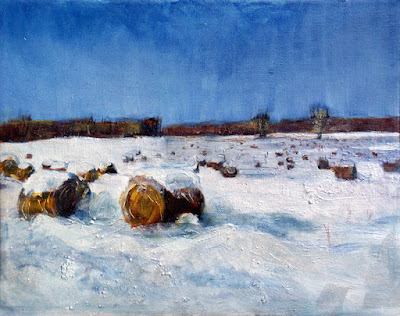Your paints will work fine; you just need to dress properly.
| Deer in snow, by Carol L. Douglas. I included this because I hit one on Saturday. She bounded off, but she’s gonna have a headache. |
Normally, plein airstudents take it easy in the dead of winter, but not my current class. They’ve trooped faithfully to my studio through the worst weather. It’s still five days until Spring, but they’re all anxious to get outdoors.
Uninsulated spaces are pretty common in Maine, where the houses are attached to barns and sheds. One of my students has his studio in one of these outbuildings. In summer, it’s delightful, but in the dead of winter he switches to watercolor so he can work in his kitchen. Now that it’s warming up again, he wants to get back to oils, but even with a woodstove, he’s unlikely to raise the temperature much above the low forties. “Do you have any tips for me?” he asked.
| Upper Reaches of the Pecos River, by Carol L. Douglas |
It’s actually easier to stay warm outside, as long as the wind isn’t blowing. Even an overcast day will have some solar gain, whereas an unheated barn can get pretty damp and cold.
The most important part of your body to insulate is your feet. Standing in one place is far more taxing than walking around in the cold. A piece of carpeting on the ground or floor will help. Always wear insulated snow boots or snowmobile boats. Don’t have them? Get some oversize Wellies and several pairs of wool socks. Yes, you’ll waddle, but agility isn’t the issue here; insulation is. (This is a “do as I say, not as I do,” statement. I’m always going out in the wrong boots.)
I wear nitrile-palm fishing gloves to paint. They’re warm enough for all but the worst days, when I add a chemical hand warmer. And dress in layers, as you would for any winter activity.
 |
| If you’re working in pastel, you have no material-handling problems at all. |
Will your paint work? Yes!
I regularly store my palettes outdoors in wintertime. I can pull them out of the snowdrift (assuming I can find them) and start painting immediately. Oil paints in a linseed oil binder don’t freeze until they reach -4.27° F or -20.15° C.
Even when we get below that point, oil paint seems to thaw with no problems. The oil binder doesn’t change color, viscosity or clarity, and nothing separates.
In the summer, I move my palettes to a freezer. Most home freezers are set at about 0° F, so the paint is very chilled but not actually frozen. The cold temperatures slow down oxidation, which makes the paint stay open longer. (I had a dedicated chest freezer for my paints, but my husband insisted on filling it up with food. Now I keep my palette in a waterproof stuff sack so that it doesn’t contaminate our future dinners.)
As long as you’re above -4.27° F, your paints will work more or less normally. They may get slightly thick as you get close to 0°; just increase the amount of solvent very slightly and they’ll be fine.
 |
| Twilight on my stone wall, by Carol L. Douglas |
If you use watercolor, you can add grain-alcohol, vodka or gin as antifreeze. A good rule of thumb is that you can add up to 20% booze to your paints before they get tipsy. But not all pigments can handle their liquor. Be prepared for excess paper staining, or different precipitation rates than you’re used to with plain water.
I know of no way, sadly, to keep acrylics from freezing.
With any medium, you’re unlikely to have precise control of your brushes when you’re bundled up and your hands are in gloves. Work loose and don’t sweat the details.





